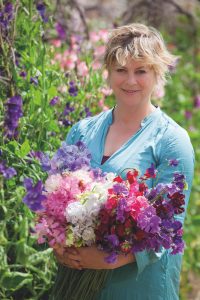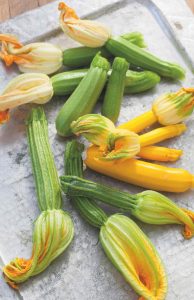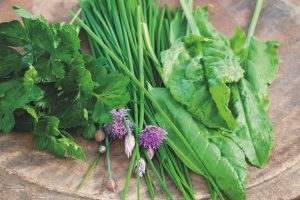Garden
In the garden with Sarah Raven

Sarah Raven holding big bunch of sweet peas
Sarah writes…
May is my favourite month. The countryside is beautiful; fluffy with cow parsley and hawthorn blossom, the woods full of bluebells and it’s the first moment we can pick armfuls of flowers and rug-loads of produce from the vegetable garden. It’s also light now, right into the evening, so you can walk out just before you want to eat and pick dinner.
What to sow now
With the soil moist and warm, the next few weeks are the perfect time for sowing veg and flowers straight into the garden. Courgettes are happy with direct sowing, and basil and zinnias positively prefer it.
I recommend a mix of three courgettes, one plant of each – the dark-green ‘Romanesco’, white-green ‘Bianca di Trieste’ and yellow ‘Soleil’ F1. That’ll give three great colours in the garden and on the plate. A traditional thing is to plant any of the squash family, including courgettes, on top of a

Mixed harvested courgettes on silver tray. Courgette ‘Bianca’ di Trieste’, ‘Romanesco’ and ‘Soleil’
compost heap – but if you can’t do that, dig a large hole – to at least a spade’s depth and a good 45cm across, and add a couple of spadefuls of manure. Then cover with the soil you’ve dug out, creating a mound in the middle into which you can sow a couple of seeds spaced 15cm apart (with one-metre spacing between mounds). Push the seed in vertically, not flat. If both germinate, thin to one. The manure helps feed the plants and ups the soil’s water retention. Both are key for good cropping – and the mound helps rain run away from the seedling’s leaves.
For zinnias, I also have three favourites ‘Queeny Red Lime’, ‘Benary’s Giant Lime’ and ‘Aztec Burgundy Bicolour’. They’re magnificent growing together and when picked for an urn with similarly coloured dahlias such as ‘Darkarin’ and ‘After Dusk’.
And for basil, it’s ‘Sweet Genovese’ you want to grow every time. Don’t let anyone persuade you that any other variety will give you such an abundance of sweet, aromatic and warmly fragrant leaves.
Both basil and zinnias do better with minimal and root disturbance, so direct sowing is best – into freely drained soil with a fine tilth. They both hate cold nights, so later in May or early June is ideal. With both, sow two seeds, 4-5cm apart, at 30cm spacing. Water them in well and wait to see what appears. If everything germinates, thin out when the seedlings reach 3-4cm to end up with one plant every 30cm.

Harvested herbs. Flat leaved parsley ‘Giant of Napoli’, French sorrel and chives
What to pick now
There’s a cheerful and ever-increasing range of food and flowers to pick over the next few months. This is a favourite moment to harvest a brilliantly coloured and varied salad. There’s still plenty of cut-and-come-again leaves, such as salad rocket, ‘Red Giant’ mustard; and ‘Mizuna’, with the pesky flea beetle yet to take its toll. The numbers of this miniature pest (shiny like a beetle, but hopping like a flea), start to rise massively soon, peppering the leaves of brassicas with tiny holes. Eat your leaves as much as you can now, before that scourge begins.
May is also a fabulous month for soft green herbs. Flat-lead parsley should have emerged unscathed after the winter, and is putting out tons of new growth. Coriander loves it now, too. It boils in a trice in the hot and dry of summer, but forms great leafy plants when there’s more moisture and less light intensity, as we usually get in May and early June. French sorrel, my favourite of all salad herbs, with its unique, sharp, lemony flavour, is growing at full tilt, so you can happily harvest handfuls a couple of times a week. It’s only when you don’t harvest sorrel that you get problems – it then tries to run to flower and seed. And add an edible flower, the petals of a marigold, borage or early rose, or perhaps a viola or pansy. These flowers are all edible. They don’t taste of much, but lift the look of your salad to another level. With both salad leaves and herbs, enclose a small bunch with elastic bands. Refresh them in cold water, soaking them for a couple of hours before drying and combining in a beautiful bowl.
Talking of beetles there are plenty of pollen beetles around now, too – the little black beetles which accumulate particularly on highly scented flowers, such as sweet peas. Don’t let this stop you picking them, as sweet peas need to be continually harvested. Instead, bring in a bunch, beetles and all, a night before you want to arrange them and leave a window open. When the sun comes up, the beetles fly towards the light and out of the window.
I love picking my sweet peas, not singly, stem by stem, but on a vine, Cut to a quarter of the plant’s total height. Harvested like that, sweet peas continue to flower longer, and I love the great scented tresses you can arrange, twisting and turning out of a vase. This makes sweet peas glamorous, rather than cottagey.
Visit sarahraven.com to receive 20% on Sarah’s wonderful gardening range. Enter code LE19MJ before 30 June 2019.
Loved this? Now read:
Floral fancy: How to use edible flowers
The wellbeing benefits of geraniums





